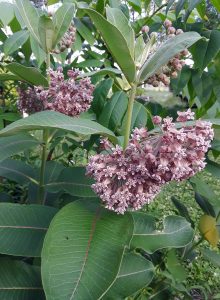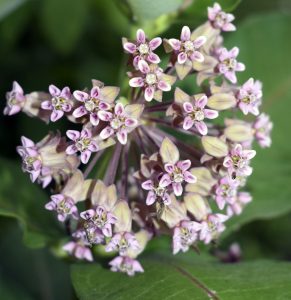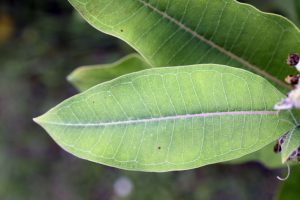Milkweed, Common
 Asclepias syriaca is found ubiquitously across Minnesota and the wider region, and has become quite persistent in my own garden once I let it in. My hesitance to eliminate common milkweed from my garden, however, stems from the fact that any of our 14 species of native milkweeds provide the only food source for the monarch butterfly caterpillars to grow on. According to a USDA research study, keeping the landscape varied with several milkweed species is important even though their study results found both swamp milkweed and common milkweed to average the highest count of eggs.
Asclepias syriaca is found ubiquitously across Minnesota and the wider region, and has become quite persistent in my own garden once I let it in. My hesitance to eliminate common milkweed from my garden, however, stems from the fact that any of our 14 species of native milkweeds provide the only food source for the monarch butterfly caterpillars to grow on. According to a USDA research study, keeping the landscape varied with several milkweed species is important even though their study results found both swamp milkweed and common milkweed to average the highest count of eggs.
Common milkweed has broader leaves than swamp milkweed for an easy ID to distinguish them, and much paler pink flowers than the hot pink swamp milkweed. The leaves of common milkweed have a unique trait in that the side veins leading out from the cream colored midrib (central vein) stop just before the leaf edge, creating an interesting border all around the margin. Flowers are about 1/2″ wide with 5 downward pointed petals dull green to mauve in color surrounding a central column that holds a 5-part corona, with horns curving from their hoods over the center column.
 June through August, take a closer look at the flowers of common milkweed, and you are sure to see a plethora of life on or about these lovely and important denizens of our landscape. One of my favorites is the red milkweed beetle, which appears in a very attractive bright red just as its namesake promises. Red milkweed beetles use the plant as a host a bit differently than you might expect compared, for example, to the caterpillar of a monarch butterfly which uses the leaves for food. Adult red milkweed beetles, not the larvae, feed on the leaves, buds and flowers of milkweed. Larvae overwinter sheltered underground beneath milkweed plants. Over the winter, the larvae derive sustenance from the milkweed roots and stems until they emerge as adults in the spring to partake of the upper parts of the plant.
June through August, take a closer look at the flowers of common milkweed, and you are sure to see a plethora of life on or about these lovely and important denizens of our landscape. One of my favorites is the red milkweed beetle, which appears in a very attractive bright red just as its namesake promises. Red milkweed beetles use the plant as a host a bit differently than you might expect compared, for example, to the caterpillar of a monarch butterfly which uses the leaves for food. Adult red milkweed beetles, not the larvae, feed on the leaves, buds and flowers of milkweed. Larvae overwinter sheltered underground beneath milkweed plants. Over the winter, the larvae derive sustenance from the milkweed roots and stems until they emerge as adults in the spring to partake of the upper parts of the plant.

